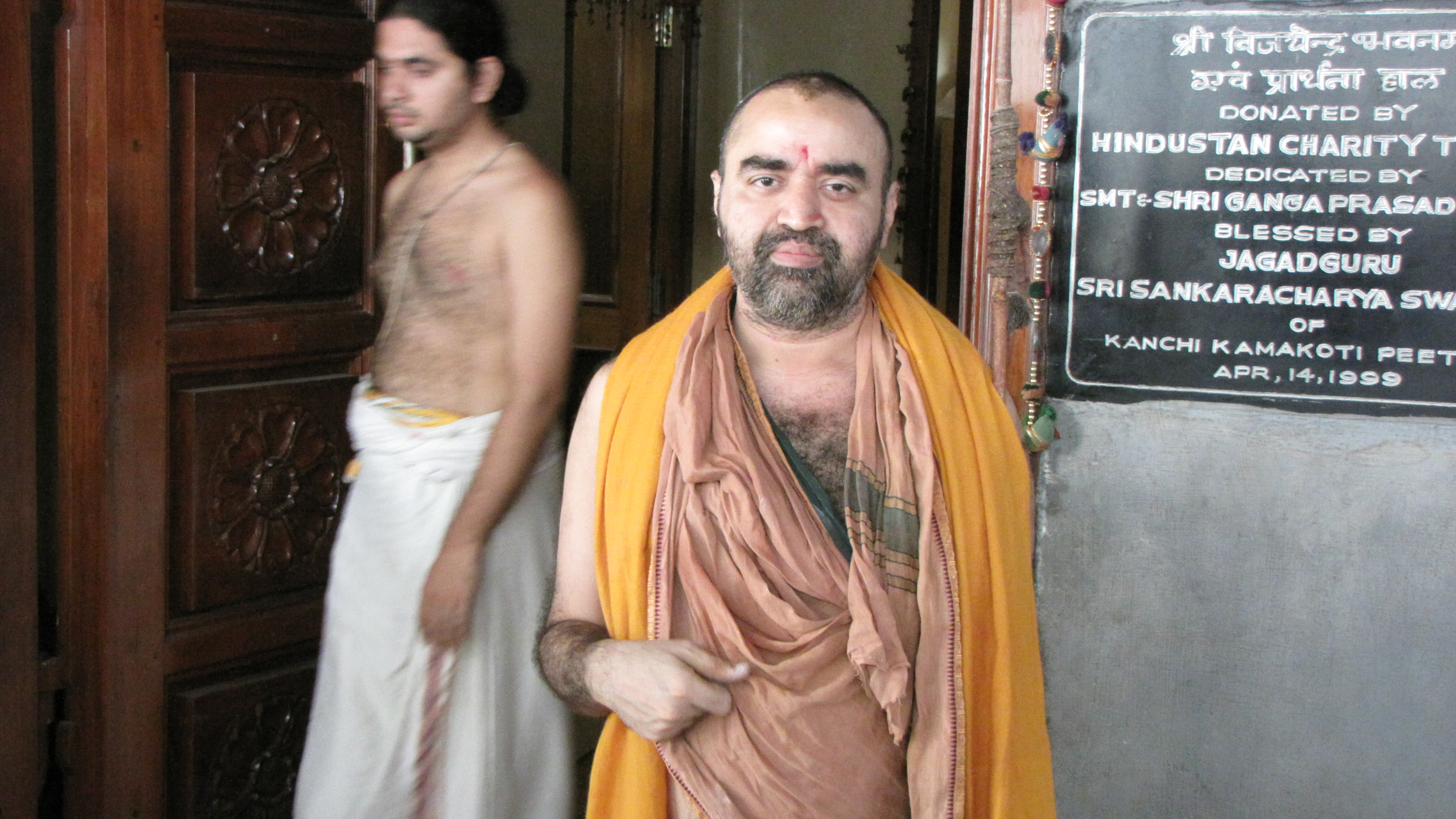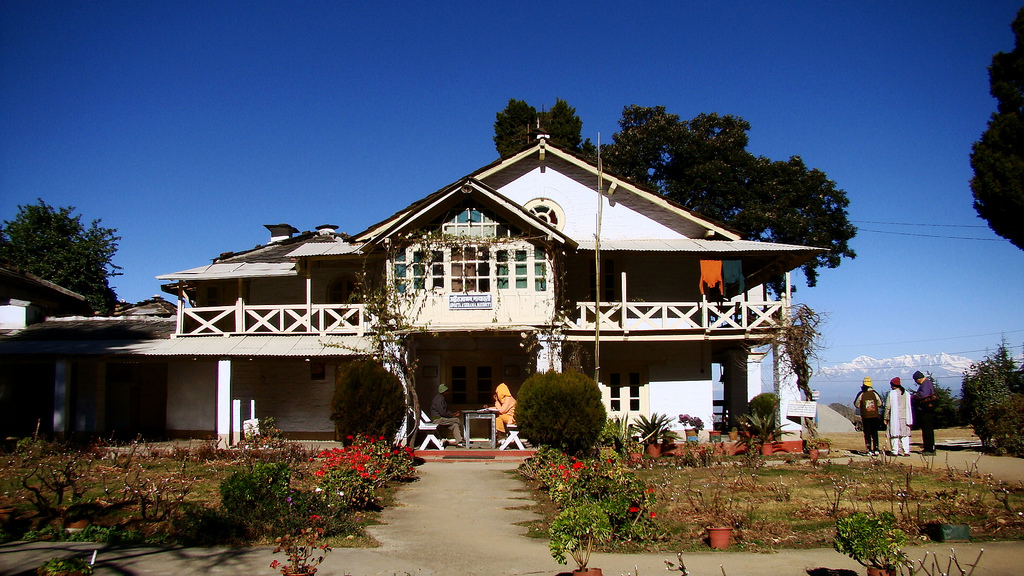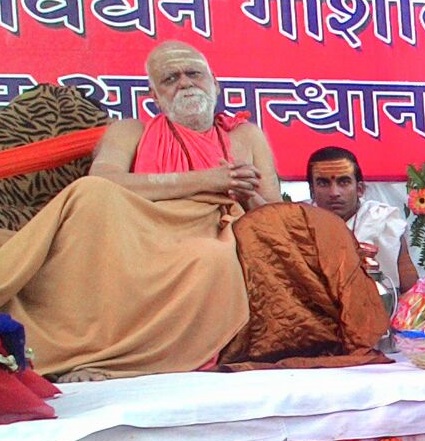|
Dwaraka Pītha
Pascimāmnāya Śrī Śāradā Pītham or Dwarka Sharada Math, is one amongst the four cardinal Matha, peethams established by the saint Adi Shankara to preserve and propagate Sanatana dharma, Sanatana Dharma and Advaita Vedanta, the doctrine of Nondualism, non-dualism. Located in the city of Dwarka, Dwaraka, Gujarat, India it is the ''pascimāmnāya matha'', or Western Āmnāya PīthamPasricha, Prem C. (1977) The Whole Thing the Real Thing, Delhi Photo Company, p. 59-63 amongst the four Chaturāmnāya Pīthams, with the others being the Sringeri Sharada Peetham, Sringeri Śāradā pīṭhaṃ (Karnataka) in the South, Govardhan Math, Purī Govardhanmaṭha Pīṭhaṃ (Odisha) in the East and Jyotir Math, Badari Jyotirmaṭha Pīṭhaṃ (Uttarakhand) in the North. It is also known as the Kālikā Matha. Their Vedantic mantra or Mahāvākyas, Mahavakya is ''Tattvamasi (That thou art) and'' as per the tradition initiated by Adi Shankara it holds authority over Sama Veda. The head of ... [...More Info...] [...Related Items...] OR: [Wikipedia] [Google] [Baidu] |
Adi Shankara
Adi Shankara ("first Shankara," to distinguish him from other Shankaras)(8th cent. CE), also called Adi Shankaracharya ( sa, आदि शङ्कर, आदि शङ्कराचार्य, Ādi Śaṅkarācāryaḥ, lit=First Shankaracharya, ), was an Indian Vedic scholar and teacher (''acharya''), whose works present a harmonizing reading of the ''sastras'', with liberating knowledge of the self at its core, synthesizing the Advaita Vedanta teachings of his time. The title of Shankracharya, used by heads of the amnaya monasteries is derived from his name. Due to his later fame, over 300 texts are attributed to his name, including commentaries (''Bhāṣya''), introductory topical expositions (''Prakaraṇa grantha'') and poetry (''Stotra''). However most of these are likely to be by admirers or pretenders or scholars with an eponymous name.W Halbfass (1983), Studies in Kumarila and Sankara, Studien zur Indologie und Iranistik, Monographic 9, Reinbeck Works known ... [...More Info...] [...Related Items...] OR: [Wikipedia] [Google] [Baidu] |
Jyotir Math
Uttarāmnāya Śrī Jyotish Pītham or Jyotir Math is one amongst the four cardinal pīthams established by the 820 CE philosopher-saint Śrī Ādi Śaṅkara to preserve and propagate Sanātana Dharma and Advaita Vedānta, the doctrine of non-dualism. Located in the city of Joshimath, Chamoli district, Uttarakhand, India, it is the uttarāmnāya ''matha'' or Northern Āmnāya Pītham, amongst the four Chaturamnaya Peethams, with the others being the Sringeri Śārada Pīṭhaṃ (Karnataka) in the South, Dvārakā Śāradā Pītham (Gujarat) in the West, and Purī Govardhanmaṭha Pīṭhaṃ (Odisha) in the East. Its appointees bear the title of Shankaracharya. It is the headquarters of Giri, Parvata & Sagara sects of the Dasnami Sampradaya (monistic order). Their Vedantic mantra or Mahavakya is ''Ayamātmānam brahma (This Atman is supreme being) and'' as per the tradition initiated by Adi Shankara it holds authority over Atharva Veda. The head of the matha is called ... [...More Info...] [...Related Items...] OR: [Wikipedia] [Google] [Baidu] |
Hinduism In Gujarat
Gujarat (, ) is a state along the western coast of India. Its coastline of about is the longest in the country, most of which lies on the Kathiawar peninsula. Gujarat is the fifth-largest Indian state by area, covering some ; and the ninth-most populous state, with a population of 60.4 million. It is bordered by Rajasthan to the northeast, Dadra and Nagar Haveli and Daman and Diu to the south, Maharashtra to the southeast, Madhya Pradesh to the east, and the Arabian Sea and the Pakistani province of Sindh to the west. Gujarat's capital city is Gandhinagar, while its largest city is Ahmedabad. The Gujaratis are indigenous to the state and their language, Gujarati, is the state's official language. The state encompasses 23 sites of the ancient Indus Valley civilisation (more than any other state). The most important sites are Lothal (the world's first dry dock), Dholavira (the fifth largest site), and Gola Dhoro (where 5 uncommon seals were found). Lothal is believed ... [...More Info...] [...Related Items...] OR: [Wikipedia] [Google] [Baidu] |
Shankaracharya Mathas In India
Shankaracharya ( sa, शङ्कराचार्य, , " Shankara-''acharya''") is a religious title used by the heads of amnaya monasteries called mathas in the Advaita Vedanta tradition of Hinduism. The title derives from Adi Shankara; teachers from the successive line of teachers retrospectively dated back to him are known as Shankaracharyas. Establishment of the tradition According to a tradition developed in the 16th century, Adi Shankara set up four monasteries known as Mathas or Peethams, in the North, South, East and West of India, to be held by realised men who would be known as Shankaracharyas. They would take on the role of teacher and could be consulted by anyone with sincere queries of a spiritual nature. Another monastery Kanchi Kamkoti Peeth in south India also derives its establishment and tradition to Adi Shankara, however its heads are called "Acharya" or "Jagadguru" instead of "Shankaracharya". The table below gives an overview of the four main Shankara ... [...More Info...] [...Related Items...] OR: [Wikipedia] [Google] [Baidu] |
Hindu Organisations Based In India
Hindus (; ) are people who religiously adhere to Hinduism.Jeffery D. Long (2007), A Vision for Hinduism, IB Tauris, , pages 35–37 Historically, the term has also been used as a geographical, cultural, and later religious identifier for people living in the Indian subcontinent. The term ''"Hindu"'' traces back to Old Persian which derived these names from the Sanskrit name ''Sindhu'' (सिन्धु ), referring to the river Indus. The Greek cognates of the same terms are "''Indus''" (for the river) and "''India''" (for the land of the river). The term "''Hindu''" also implied a geographic, ethnic or cultural identifier for people living in the Indian subcontinent around or beyond the Sindhu (Indus) River. By the 16th century CE, the term began to refer to residents of the subcontinent who were not Turkic or Muslims. Hindoo is an archaic spelling variant, whose use today is considered derogatory. The historical development of Hindu self-identity within the local In ... [...More Info...] [...Related Items...] OR: [Wikipedia] [Google] [Baidu] |
Kanchi Kamakoti Peetham
Sri Kanchi Kamakoti Peetham, also called the Sri Kanchi Matham or the Sri Kanchi Monastery or the Sarvagna Peetha, is a Hindu institution, located in Kanchipuram, Tamil Nadu. It is located near a temple dedicated to Goddess Sri Kamakshi (Durga, Kamakoti, Maha Tripurasundari) of the Shaktism tradition, along with a shrine for the Advaita Vedanta teacher Adi Shankara. The matha-tradition attributes its founding to Adi Shankara, but this and the reliability of the matha's succession list has been questioned. The Kanchi Math was originally established as the Kumbakonam Mutt in 1821 as a branch of the Sringeri Mutt, and later became involved with the Kamakshi temple in Kanchipuram. According to the Sri Kanchi math tradition, the matha was founded at Kanchipuram, and shifted south to the temple city of Kumbakonam in mid-18th-century due to the on-going wars, when there was warfare in the region, and returned to Kanchipuram in the 19th century. The matha is a living tradition, ... [...More Info...] [...Related Items...] OR: [Wikipedia] [Google] [Baidu] |
Kalady
Kalady or Kaladi is a town located between Angamaly and Perumbavoor, east of the Periyar river, near to Malayattoor in Ernakulam district of Kerala, India, not far from Cochin International Airport. It is notable as the birthplace of 9th century Indian philosopher Adi Shankara. Kalady came to prominence only after its rediscovery in the late 19th century by the then Shankaracharya of Sringeri and the subsequent consecration of an Adi Shankara temple in 1910. The centenary of Kalady was celebrated in May 2010, and the story of its re-discovery a hundred years ago has been documented in a film by the Sringeri Sharada Peetham.Cochin international airport is situated just 6 km away from the city Location Etymology In Malayalam, ''Kalady'' means "footprint". The village was previously called Sasalam. Almost all traditional and hagiographical sources maintain that Kalady was Shankara's birthplace. It is situated on the banks of river Periyar. Kalady is believed to have been fou ... [...More Info...] [...Related Items...] OR: [Wikipedia] [Google] [Baidu] |
Swarupananda Saraswati
Swarupananda (8 July 1871 – 27 June 1906) was a direct monastic disciple of Vivekananda and the first president of the Advaita Ashrama, set up by Vivekananda in 1899 at Mayavati, near Champawat. The ashram is a branch of the religious monastic order, Ramakrishna Math, also set up by Vivekananda on the teachings of his guru Ramakrishna. Swarupananda remained as editor of ''Prabuddha Bharata'', an English-language monthly journal of the Ramakrishna Order, when it shifted base from Chennai in 1898 and remained so till 1906. Vivekananda exclaimed to Sara Bull and other friends about the young disciple whom he had initiated into the monastic order, "we have made an acquisition today." Pre Monastic life Swarupananda's pre monastic name was Ajay Hari Bannerjee. He was born on 8 July 1871 at Bhawanipur in Calcutta, in a well-to-do Brahmin family. Early experiences with sorrows and tribulations in life and human misery inspired him to develop a spiritual outlook. He developed frien ... [...More Info...] [...Related Items...] OR: [Wikipedia] [Google] [Baidu] |
Swaroopanand Saraswati
Swami Swaroopanand Saraswati (2 September 1924 – 11 September 2022) was an Indian religious leader. In 1982, he became the Shankaracharya of Dwarka Sharada Peetham in Dwaraka, Gujarat and also caretaker of the Jyotir Math in Badrinath. Life Swaroopanand Saraswati was born Pothiram Upadhyay on 2 September, 1924 at Dighori village of Seoni district, Madhya Pradesh. A direct disciple of Shankaracharya Brahmananda Saraswati of Jyotir Math (1941–1953) and of Shankaracharya (disputed) Krishnabodha Ashrama of Jyotir Math (1953–1973), in 1950 his Guru Brahmananda made him a Dandi Sannyasi. Swami Swaroopanand became president of the Akhil Bharatiya Ram Rajya Parishad, established by Swami Karpatri. On Swami Krishnabodha Ashrama's demise in 1973 the title of Shankaracharya (disputed) of Jyotir Math, Badrinath passed to Swami Swaroopanand. Later he also became the Shankaracharya of Dwarka peeth in 1982. To date (2021) Swami Swaroopanand's claim to title of Shankaracharya of Jyot ... [...More Info...] [...Related Items...] OR: [Wikipedia] [Google] [Baidu] |
Shankaracharya
Shankaracharya ( sa, शङ्कराचार्य, , "Adi Shankara, Shankara-''acharya''") is a religious title used by the heads of amnaya monasteries called mathas in the Advaita Vedanta tradition of Hinduism. The title derives from Adi Shankara; teachers from the successive line of teachers retrospectively dated back to him are known as Shankaracharyas. Establishment of the tradition According to a tradition developed in the 16th century, Adi Shankara set up four monasteries known as Mathas or Peethams, in the North, South, East and West of India, to be held by realised men who would be known as Shankaracharyas. They would take on the role of teacher and could be consulted by anyone with sincere queries of a spiritual nature. Another monastery Kanchi Kamakoti Peetham, Kanchi Kamkoti Peeth in south India also derives its establishment and tradition to Adi Shankara, however its heads are called "Acharya" or "Jagadguru" instead of "Shankaracharya". The table below gives ... [...More Info...] [...Related Items...] OR: [Wikipedia] [Google] [Baidu] |
Mahāvākyas
The Mahāvākyas (''sing.:'' mahāvākyam, महावाक्यम्; ''plural:'' mahāvākyāni, महावाक्यानि) are "The Great Sayings" of the Upanishads, as characterized by the Advaita school of Vedanta with mahā meaning great and vākya, a sentence. Most commonly, ''Mahāvākyas'' are considered four in number, # ''Tat Tvam Asi (तत् त्वम् असि)'' - traditionally rendered as "That Thou Art" (that you are), (Chandogya Upanishad 6.8.7 of the Sama Veda, with '' tat'' in Ch.U.6.8.7 referring to '' sat'', "the Existent"); alternatively translated as "That's how husyou are," with ''tat'' in Ch.U.6.12.3 referring to "the very nature of all existence as permeated by he finest essence # ''Aham Brahmāsmi'' (अहम् ब्रह्मास्मि)'' - "I am Brahman", or "I am Divine" (Brihadaranyaka Upanishad 1.4.10 of the Yajur Veda)'' # '' Prajnanam Brahma (प्रज्ञानम् ब्रह्म)'' - "Prajñāna ... [...More Info...] [...Related Items...] OR: [Wikipedia] [Google] [Baidu] |
Govardhan Math
Purvamnaya Sri Govardhana Peetham or Govardhan Math is one amongst the four cardinal peethams established by the philosopher-saint Bhagwan Adi Shankaracharya to preserve and propagate Sanatana Dharma and Advaita Vedanta, the doctrine of non-dualism. Located in Puri in Odisha, India, it is the Eastern Āmnāya Pītham amongst the four Chaturamnaya Peethams, with the others being the Sringeri Śārada Pīṭhaṃ (Karnataka) in the South, Dvārakā Śāradā Pītham (Gujarat) in the West, and Badari Jyotirmaṭha Pīṭhaṃ (Uttarakhand) in the North. It is associated with the Jagannath temple. Their Vedantic mantra or Mahavakya is ''Prajñānam brahma (Consciousness is supreme being) and'' as per the tradition initiated by Adi Shankara it holds authority over Rig Veda. The head of the matha is called Shankarayacharya, the title derives from Adi Shankara. The deities here are Jagannath (Lord Vishnu) and the devi is Vimala (Bhairavi). There are Shri Vigrahas of ''Govardhana ... [...More Info...] [...Related Items...] OR: [Wikipedia] [Google] [Baidu] |





.jpg)




